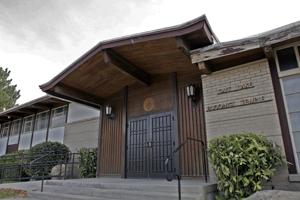Salt Lake Buddhist Temple Prospers
By Brenda Lewis, Globe Link - Community, March 31, 2005
Salt Lake City, Utah (USA) -- In the downtown area known as Temple Square there are more temples than one might expect. A temple to the Jazz, the Delta Center is prominent and Abravanel Hall, a temple to the Arts proudly stands. Tucked humbly away is the Salt Lake Buddhist Temple at 211 W. and 100 S.
 << Salt Lake Buddhist Temple. Media Credit: John Fitzgerald
<< Salt Lake Buddhist Temple. Media Credit: John Fitzgerald
One of 63 temples within the Buddhist Churches of America, the Salt Lake Buddhist Temple traces its origin in Salt Lake to the fall of 1912. The BCA was founded in Sept. 1899 in San Francisco, CA. In 1912, Rev. Koyo Uchida came to Ogden, UT to conduct a memorial service for deceased, first generation Japanese pioneers.
These early immigrants, the Issei, came to Utah to work on the railroads. Once that work was finished they went to work in mining labor camps. Their lives were difficult and they turned to their homeland religion to maintain their human dignity. Jodo Shinshu is the sect of Buddhism most practiced in Japan, with over 10,000 temples throughout that country.
Shinan Shonin (1173-1263) is the founder of the Jodo Shinshu sect. A Buddhist, Shonin interpreted established doctrine in innovative ways that appealed to the masses. The most significant influences were his beliefs that enlightenment was possible for the common man, that the monastic tradition was not essential to enlightenment, and the power of Amida Buddha was greater than self-power in achieving spiritual peace.
The Issei ministers were educated and they did everything for the Japanese community from driving children to Sunday school to writing letters for illiterate mine workers. In 1918, The Buddhist Women's Association formed, and became a stabilizing force in the Salt Lake Temple. Many of the Issei felt that their children would do better in their new country by foregoing their own religion. Despite this, Rev. Renjo Hirowaza organized the Sunday school in 1918. This School was the beginning of the current Dharma School. In the Sunday school, second generation Japanese (Nesei) learned gratitude and reliance on Amida Buddha. Seeing their parents face adversity by relying on the teachings of Jodo Shinshu, inspired the Nesei to support the temple.
During World War II, temple activities were disrupted by the internment of Japanese ministers and leaders in camps at Topaz Mountain. Rev. Chonen Terakawa was relocated with other Japanese Americans and his wife, an ordained minister herself, conducted services in his absence.
After WWII, the Sunday school was re-organized and now teachings were done in English as well as Japanese. The public was also welcomed to attend Sunday morning services. The hard work and diligence of ministers and members has sustained the temple and made it what it is today.
Plain by any standard, the outside of the temple is decorated only by a large magnolia tree on its east wall. Inside the temple, it's a different story. Three golden altars (Naijin) dominate the chapel (Hondo). The center altar (Gohonzon) contains a gold statue of Amida Buddha. This altar is the principal object of reverence and serves to remind all of the importance of compassion. The altars on either side of the Gohonzon hold picture scrolls of Shinan Shonin and Rennyo Shonin (1415-1499). Rennyou Shonin is attributed as being responsible for the spread of Jodo Shinshu.
Above the Naijin is a golden framed plaque with the inscription 'Dai Jihi' in Chinese characters. This means Great Compassion which signifies Amida Buddha.
The Sunday Service is conducted by children, with the current minister giving the Dharma Talk or sermon.
The Dharma Talk on Easter was about calligraphy. Rev. Jerry K. Hirano had the flu and another member of the temple gave the talk. He explained that calligraphy is an expression of each artist's attitude. Holding up a large example of his own work, he explained that he chose a broad brush and dark, dark ink to paint his symbol of kharma because, to him, kharma is a burden to man.
The fragrant incense and soothing hymns of the service made for a peaceful 35 minutes. 'Namo Amido Batsu' is a phrase that was repeated often throughout the service. Saying this phrase is the only requirement in Jodo Shinshu. By purposefully saying it, the chanter acknowledges the power of Amida Buddha to relieve him of his self-centered limitations.
The temple is currently engaged in a fund drive to raise $2 million so that they can build a new temple. The current minister Rev. Jerry K. Hirano has energized the Japanese American community and the growth of the temple's membership is bigger than their building. Additionally, the Salt Lake City Master Plan does not include the Salt Lake Buddhist Temple and it is inevitable that, at some point, the city will want the location for another purpose.
Services are held every morning at 10 a.m. if Rev. Hirano is at the temple. Some of the information in this article was obtained at http://www.slbuddhist.org.

 << Salt Lake Buddhist Temple. Media Credit: John Fitzgerald
<< Salt Lake Buddhist Temple. Media Credit: John Fitzgerald